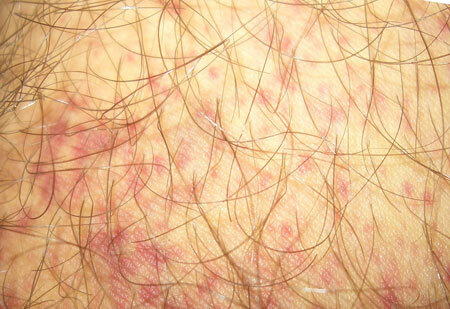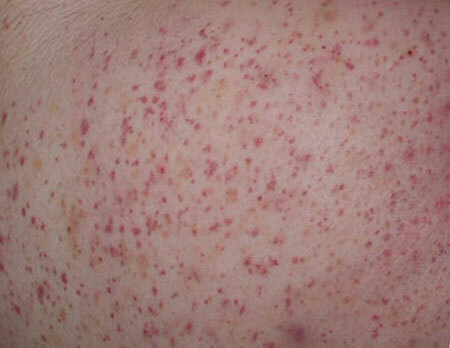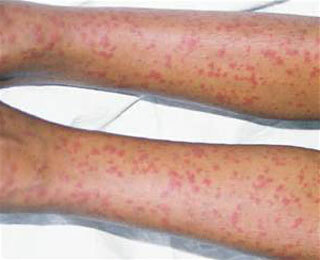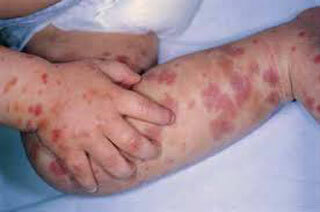This disease, called in medicine by the Henry Henoch syndrome or allergic( rheumatic) purpura, is diagnosed mainly in patients aged 5-13 years. In adults, cases of hemorrhagic vasculitis are also frequent.
Less often, it occurs in children under the age of 3 years. The development of this disease is always associated with damage to the walls of vascular beds, increased degree of their permeability, activation of the protein metabolism process, increased production of immune responses.
Contents
- 1 Hemorrhagic vasculitis: what is it?
- 2 Signs and symptoms of hemorrhagic vasculitis, photo
- 3 forms of hemorrhagic vasculitis
- 3.1 hemorrhagic vasculitis: skin-articular form
- 4 diagnosis of hemorrhagic vasculitis
- 5 Treatment of hemorrhagic vasculitis
- 6 hemorrhagic vasculitis in children
- 6.1 Complications hemorrhagic vasculitis
- 6.2 prevention of hemorrhagic vasculitis
hemorrhagic vasculitis: what it is?

Hemorrhagic vasculitis is a systemic disease of the vasculitis series, characterized by the defeat of the walls of the smallest blood vessels of the body - capillaries, venules and arterioles. This condition is always accompanied by a violation of the structure of these blood streams.
As a rule, the disease occurs with the presence of aseptic inflammation, which significantly increases the likelihood of blood clots. In the presence of rheumatic purpura, not only the blood streams of the skin cover, but also the internal organs( joints, kidneys, gastrointestinal tract) suffer.
Causes of hemorrhagic vasculitis
The main triggering mechanism of this disease is an infection of various etiologies. These can be fungi, bacteria or viruses. Also, the development of the disease affects the intake of certain medications, the unfavorable environmental conditions in which the patient lives.
Predisposing factors to the occurrence of hemorrhagic vasculitis are:
- insect bites;
- thermal burns;
- trauma of various origins;
- intoxication due to ingestion of biological poisons;
- vaccination procedures;
- congenital functional disorders of the immune system;
- colds;
- overheating or hypothermia of the body;
- allergic reactions caused by food agents.
Signs and symptoms of hemorrhagic vasculitis, photo

photo of symptoms on the skin
1. Skin rashes
Symptoms of hemorrhagic vasculitis in adults are manifested by hemorrhagic papules( rash) of small diameter that are formed mainly on the skin of the buttocks, feet, thighs, and lower legs,on the skin of the upper body. The rash has a rich red color and does not disappear when pressed. Sometimes papules form conglomerates. Rashes, as a rule, are located symmetrically.
The severity of the course of hemorrhagic vasculitis is of great importance. Symptoms may also have a different intensity.
In a particularly severe course of the disease, a small accumulation of purulent exudate appears in the center of the papules, which leads to the formation of erosion. If there is a chronic form, ulcers tend to heal, and then on the skin there is abundant peeling and persistent pigmentation.
2. Acute onset of
diseaseAllergic purpura mainly occurs in the spring season and is characterized by a sharp current at the initial stages of its development. Often this happens after the transferred infectious pathology of the respiratory system. The condition is often accompanied by an increase in body temperature, both subfebrile and significant.
3. Failures in the work of the digestive tract
Stool disorder, nausea, repeated vomiting, abdominal pain - all these signs indicate that the patient developed hemorrhagic vasculitis, the syndromes of abdominal manifestations of which can have different intensity. And patients can not specify the exact localization of pain.
4. Joint damage
This symptom occurs in 75% of patients. Syndrome Shenlaine Henoch is accompanied by soreness, swelling and redness of the skin in the joints. Sometimes such a symptomatology as expressed, that there is a restriction of joint / joint mobility.
Most often suffer from large joints, for example, elbows, ankles, knees.
5. Kidney damage
In 3 patients out of 10, the disease is accompanied by glomerulonephritis. The degree of hematuria can be different. The defeat of the kidneys against the background of rheumatic purpura can lead to the development of renal failure.
Forms of hemorrhagic vasculitis
In medicine, this pathology is classified according to the manifestations that accompany its course.
- Skin and abdominal. The organs of the digestive system are affected, the pain syndrome in the peritoneal region is pronounced, often there is an intestinal colic, there is a skin rash.
- Skin. With the development of this form of disease, the lesion affects only the skin, on which there are clearly delineated exanthemes of dark cherry color. Most often, the rash is localized near the joints on the extensor surfaces of the lower( rarely upper) limbs and buttocks. Against the background of exanthem appears papular rash, which is often accompanied, for example, skin-abdominal hemorrhagic vasculitis. The cutaneous form of this disease has a tendency to intense itching in the area of formation of papules and exanthem.
- Skin and joint. Along with hemorrhagic papules, there is damage to the joint tissues. Most often these are knee, ankle and elbow joints.
- Renal. In this case, the patients have kidney lesions of different genesis. Skin rash is absent.
Hemorrhagic vasculitis: dermal-articular form

Dermal-articular form of hemorrhagic vasculitis deserves a separate description - it is characterized by rapid development. Sometimes, before the onset of the disease, a person experiences headaches and general malaise combined with an increased body temperature.
On the surface of the skin, as a result of numerous hemorrhages, small red spots of a rounded shape are formed. More often they merge with each other.
Also, the cutaneous and articular form of the pathology is characterized by the appearance of blisters, inflammatory foci, puffiness of the skin and soft tissues in the joint region. If the course of vasculitis is particularly severe, the skin-joint form can go into a necrotic form.
Diagnosis of hemorrhagic vasculitis
The changes experienced by the patient's biological samples during a laboratory examination can not be called specific. To confirm the diagnosis, attention is drawn to the level:
- ESR;
- platelets;
- of leukocytes;
- alpha-2-globulin;
- of immunoglobulins A and G;
- reactive proteins;
- seromucoids;
- fibrinolysis;
- fibrinogen;
- cryoglobulins;
- DFA;
- antigualuronidase;
- fibrin monomers;
- antistreptolysin.
During the research it is necessary to differentiate hemorrhagic vasculitis. Diagnosis of the disease is not difficult for doctors.
The difficulty can be only in determining its form of development and the possibility of confusing, for example, abdominal pathology with some other disease:
- with intestinal obstruction;
- pancreatitis;
- cholecystitis;
- by peritonitis;
- with an inflammation of the appendix.
Also hemorrhagic papules can be one of the manifestations:
- thrombocytopenia;
- cryoglobulinemic vasculitis;
- of paraneoplastic syndrome;
- sepsis;
- of meningococcal meningitis.
Treatment of hemorrhagic vasculitis

Traditional methods of
The duration and nature of treatment of hemorrhagic vasculitis in children and adults depends on the severity, clinical form and phase of its development. With all forms of the disease, antiaggregants are prescribed - Trental and Curantil. In particularly severe cases, in order to enhance the anti-aggregation effect, the patient is prescribed two of these drugs simultaneously.
Also prescribed and taking anticoagulants. Laughter reception, single and daily dosages are selected individually for each patient. Often patients are prescribed intravenous or subcutaneous injection of Heparin. In the second variant, the drug enters the body through fatty tissue in the abdominal region.
If necessary, the doctor prescribes fibrinolysis activators. These are nicotinic acid and all its derivatives. In addition to these drugs, the following are prescribed:
- glucocorticosteroids;
- vitamins E and A;
- membrane stabilizers;
- cytostatics;
- analgesics;
- antispasmodics;
- enterosorbents;
- is an anti-inflammatory.
In the treatment of hemorrhagic vasculitis in adults, the passage of the plasmapheresis procedure can be indicated. The method of choice is chosen based on the severity of the pathology. By means of plasmapheresis it is possible to achieve purification of blood plasma from toxic agents at the molecular level.
Surgery
Surgical methods of treatment are carried out in extreme cases - when a new kidney is required to be replaced in return for the affected one, whose functions can not be restored. Also, surgical intervention can be performed on the intestine in order to remove the affected area.
Hemorrhagic vasculitis in the ICD is classified as severe vascular pathologies and is a type of immune vasculitis. It is denoted by the code D69.0 and is more often called allergic purpura.
Folk methods
1. Pass through the meat grinder 3 lemons and 2 pieces.cloves( spice).Add 500 g of sugar to the mixture and pour in warm water( 1.5 l).Put the mass in a glass jar with a lid and remove it for 15 days in a dark place. At the end of the period, take the remedy three times a day before eating until 15 g.
2. Grind 5 parts of rue leaves and add 1 part of butter to them( can be replaced with vegetable oil).Stir well and place in a glass container, which is left for 10 days in a dark, dry place. When the mixture is infused, rub it 4 times a day in the affected area.
3. Finely chop and mix the herbs( 10 g each): mint, marigold, horsetail, string, poplar buds, elderberry and yarrow.
Each morning, pour 10 grams of herbal mixture with boiling water( 300 ml), insist, filter and drink the infusion, dividing it into three meals.
Hemorrhagic vasculitis in children

symptoms of hemorrhagic vasculitis in children, photo
Parents may not immediately suspect that the child has fallen ill with allergic purpura, and skip the onset of the disease, as in 50% of small patients it flows without the formation of skin rashes.
Doctors recommend paying attention to the change in the behavior and mood of the baby. He will become restless or, on the contrary, sluggish, he will have subfebrile temperature and loss of appetite. If you find this symptomatology, contact your health care provider immediately.
Above( in the section on signs and symptoms) information was presented on the manifestations of hemorrhagic vasculitis in adults. As for children, the symptoms of allergic purpura look somewhat different:
- is a high probability of the development of generalization and relapse processes;
- abdominal tenderness;
- with stool discomfort, nausea and vomiting( sometimes);
- extremely acute onset and subsequent course of the disease;
- is limited by angioedema in the joint zone;
- with an intense exudative component.
Complications of hemorrhagic vasculitis
In the absence of timely and adequate treatment of this pathology, serious negative consequences can occur in the form of:
- renal failure;
- disorders of the liver and heart;
- iron deficiency anemia;
- pulmonary hemorrhage;
- of intestinal obstruction;
- peritonitis;
- hemorrhagic diathesis.
Prevention of hemorrhagic vasculitis
- Avoid intensive physical exertion.
- Strengthen immunity.
- Until the end cure infectious diseases.
- Do not overcool the body.
- Do not self-medicate any disease when there is uncontrolled use of medication.
Promptly seek help if you find the first signs of hemorrhagic vasculitis. While the disease is at an early stage of development, it is easily treatable.
Otherwise, there may be deplorable consequences, up to a lethal outcome due to acute renal syndrome, cerebral hemorrhage or CNS vascular lesions. Take care of your health!



